
Johann Ludwig Heinrich Julius Schliemann was a German businessman and an influential amateur archaeologist. He was an advocate of the historicity of places mentioned in the works of Homer and an archaeological excavator of Hisarlik, now presumed to be the site of Troy, along with the Mycenaean sites Mycenae and Tiryns. His work lent weight to the idea that Homer's Iliad reflects historical events. Schliemann's excavation of nine levels of archaeological remains has been criticized as destructive of significant historical artifacts, including the level that is believed to be the historical Troy.

Linear A is a writing system that was used by the Minoans of Crete from 1800 BC to 1450 BC. Linear A was the primary script used in palace and religious writings of the Minoan civilization. It was succeeded by Linear B, which was used by the Mycenaeans to write an early form of Greek. It was discovered by the archaeologist Sir Arthur Evans in 1900. No texts in Linear A have yet been deciphered. Evans named the script "Linear" because its characters consisted simply of lines inscribed in clay, in contrast to the more pictographic characters in Cretan hieroglyphs that were used during the same period.

Linear B is a syllabic script that was used for writing in Mycenaean Greek, the earliest attested form of the Greek language. The script predates the Greek alphabet by several centuries, the earliest known examples dating to around 1400 BC. It is adapted from the earlier Linear A, an undeciphered script potentially used for writing the Minoan language, as is the later Cypriot syllabary, which also recorded Greek. Linear B, found mainly in the palace archives at Knossos, Kydonia, Pylos, Thebes and Mycenae, disappeared with the fall of Mycenaean civilization during the Late Bronze Age collapse. The succeeding period, known as the Greek Dark Ages, provides no evidence of the use of writing.

Troy or Ilion was an ancient country located in present-day Hisarlık, Turkey. The place was first settled around 3600 BC and grew into a small fortified city around 3000 BC. During its four thousand years of existence, Troy was repeatedly destroyed and rebuilt. As a result, the archeological site that has been left is divided into nine layers, each corresponding to a city built on the ruins of the previous. Archaeologists refer to these layers using Roman numerals. Among the early layers, Troy II is notable for its wealth and imposing architecture. During the Late Bronze Age, Troy was called Wilusa and was a vassal of the Hittite Empire. The final layers were Greek and Roman cities which in their days served as tourist attractions and religious centers because of their link to mythic tradition.
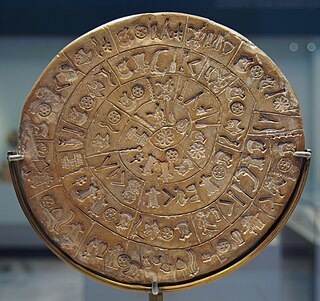
The Phaistos Disc or Phaistos Disk is a disk of fired clay from the island of Crete, Greece, possibly from the middle or late Minoan Bronze Age, bearing a text in an unknown script and language. Its purpose and its original place of manufacture remain disputed. It is now on display at the archaeological museum of Heraklion. The name is sometimes spelled Phaestos or Festos.

Luwian, sometimes known as Luvian or Luish, is an ancient language, or group of languages, within the Anatolian branch of the Indo-European language family. The ethnonym Luwian comes from Luwiya – the name of the region in which the Luwians lived. Luwiya is attested, for example, in the Hittite laws.

Cuneiform is a logo-syllabic writing system that was used to write several languages of the Ancient Near East. The script was in active use from the early Bronze Age until the beginning of the Common Era. Cuneiform scripts are marked by and named for the characteristic wedge-shaped impressions which form their signs. Cuneiform is the earliest known writing system and was originally developed to write the Sumerian language of southern Mesopotamia.

The Cypriot or Cypriote syllabary is a syllabic script used in Iron Age Cyprus, from about the 11th to the 4th centuries BCE, when it was replaced by the Greek alphabet. It has been suggested that the script remained in use as late as the 1st century BC. A pioneer of that change was King Evagoras of Salamis. It is thought to be descended from the Cypro-Minoan syllabary, itself a variant or derivative of Linear A. Most texts using the script are in the Arcadocypriot dialect of Greek, but also one bilingual inscription was found in Amathus.
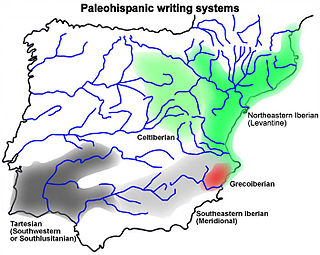
The Celtiberian script is a Paleohispanic script that was the main writing system of the Celtiberian language, an extinct Continental Celtic language, which was also occasionally written using the Latin alphabet. This script is a direct adaptation of the northeastern Iberian script, the most frequently used of the Iberian scripts.
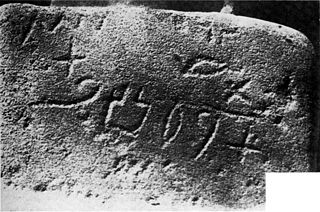
The Proto-Sinaitic script is a Middle Bronze Age writing system known from a small corpus of about 30-40 inscriptions and fragments from Serabit el-Khadim in the Sinai Peninsula, as well as two inscriptions from Wadi el-Hol in Middle Egypt. Together with about 20 known Proto-Canaanite inscriptions, it is also known as Early Alphabetic, i.e. the earliest trace of alphabetic writing and the common ancestor of both the Ancient South Arabian script and the Phoenician alphabet, which led to many modern alphabets including the Greek alphabet. According to common theory, Canaanites or Hyksos who spoke a Canaanite language repurposed Egyptian hieroglyphs to construct a different script.

Anatolian hieroglyphs are an indigenous logographic script native to central Anatolia, consisting of some 500 signs. They were once commonly known as Hittite hieroglyphs, but the language they encode proved to be Luwian, not Hittite, and the term Luwian hieroglyphs is used in English publications. They are typologically similar to Egyptian hieroglyphs, but do not derive graphically from that script, and they are not known to have played the sacred role of hieroglyphs in Egypt. There is no demonstrable connection to Hittite cuneiform.

Eteocypriot is an extinct non-Indo-European language that was spoken in Cyprus by a non-Hellenic population during the Iron Age. The name means "true" or "original Cypriot" parallel to Eteocretan, both of which names are used by modern scholars to mean the non-Greek languages of those places. Eteocypriot was written in the Cypriot syllabary, a syllabic script derived from Linear A. The language was under pressure from Arcadocypriot Greek from about the 10th century BC and finally became extinct in about the 4th century BC.

The Byblos script, also known as the Byblos syllabary, Pseudo-hieroglyphic script, Proto-Byblian, Proto-Byblic, or Byblic, is an undeciphered writing system, known from ten inscriptions found in Byblos, a coastal city in Lebanon. The inscriptions are engraved on bronze plates and spatulas, and carved in stone. They were excavated by Maurice Dunand, from 1928 to 1932, and published in 1945 in his monograph Byblia Grammata. The inscriptions are conventionally dated to the second millennium BC, probably between the 18th and 15th centuries BC.
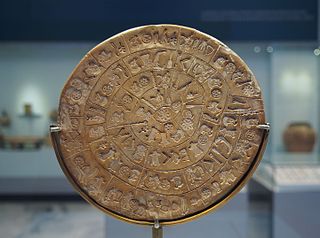
Many people have claimed to have deciphered the Phaistos Disc.
The Trojan language was the language spoken in Troy during the Late Bronze Age. The identity of the language is unknown, and it is not certain that there was one single language used in the city at the time.

Linear Elamite was a writing system used in Elam during the Bronze Age between c. 2300 and 1850 BCE, and known mainly from a few extant monumental inscriptions. It was used contemporaneously with Elamite cuneiform and records the Elamite language. The French archaeologist François Desset and his colleagues have argued that it is the oldest known purely phonographic writing system, although others, such as the linguist Michael Mäder, have argued that it is partly logographic.

Mycenaean pottery is the pottery tradition associated with the Mycenaean period in Ancient Greece. It encompassed a variety of styles and forms including the stirrup jar. The term "Mycenaean" comes from the site Mycenae, and was first applied by Heinrich Schliemann.
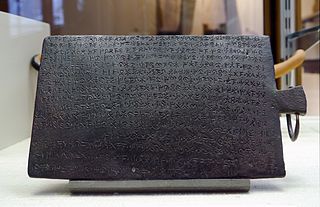
The Idalion Tablet is a 5th-century BC bronze tablet from Idalium, Cyprus. The script of the tablet is in the Cypriot syllabary and the inscription itself is in the Arcadocypriot dialect of Greek.
Luwian Studies is an independent, private, non-profit foundation based in Zürich, Switzerland. Its sole purpose is to promote the study of cultures of the second millennium BC in western Asia Minor. The foundation encourages and supports archaeological, linguistic and natural scientific investigations to complete the understanding of Middle and Late Bronze Age Mediterranean cultures. Western Anatolia was, at that point in time, home to groups of people who spoke Luwian, an Indo-European language.


















